Integration of Maritime Transportation with Other Modes of Transport
VerifiedAdded on 2022/11/24
|5
|906
|213
Report
AI Summary
This report examines the integration of maritime transport with other modes of transportation, focusing on the challenges of port congestion and complex documentation processes. It highlights the significance of these problems, emphasizing the need for efficient goods movement and reduced operational costs. The report presents two alternative solutions: implementing a single window system for documentation and utilizing advanced technology and automation to estimate demand. It recommends strategic management of goods and inventory, preplanning, and effective demand forecasting through automation, along with the integration of maritime and air cargo operations. The report underscores the importance of containerization and the need for flexibility in transportation modes to meet contemporary demands. References are included for further research.
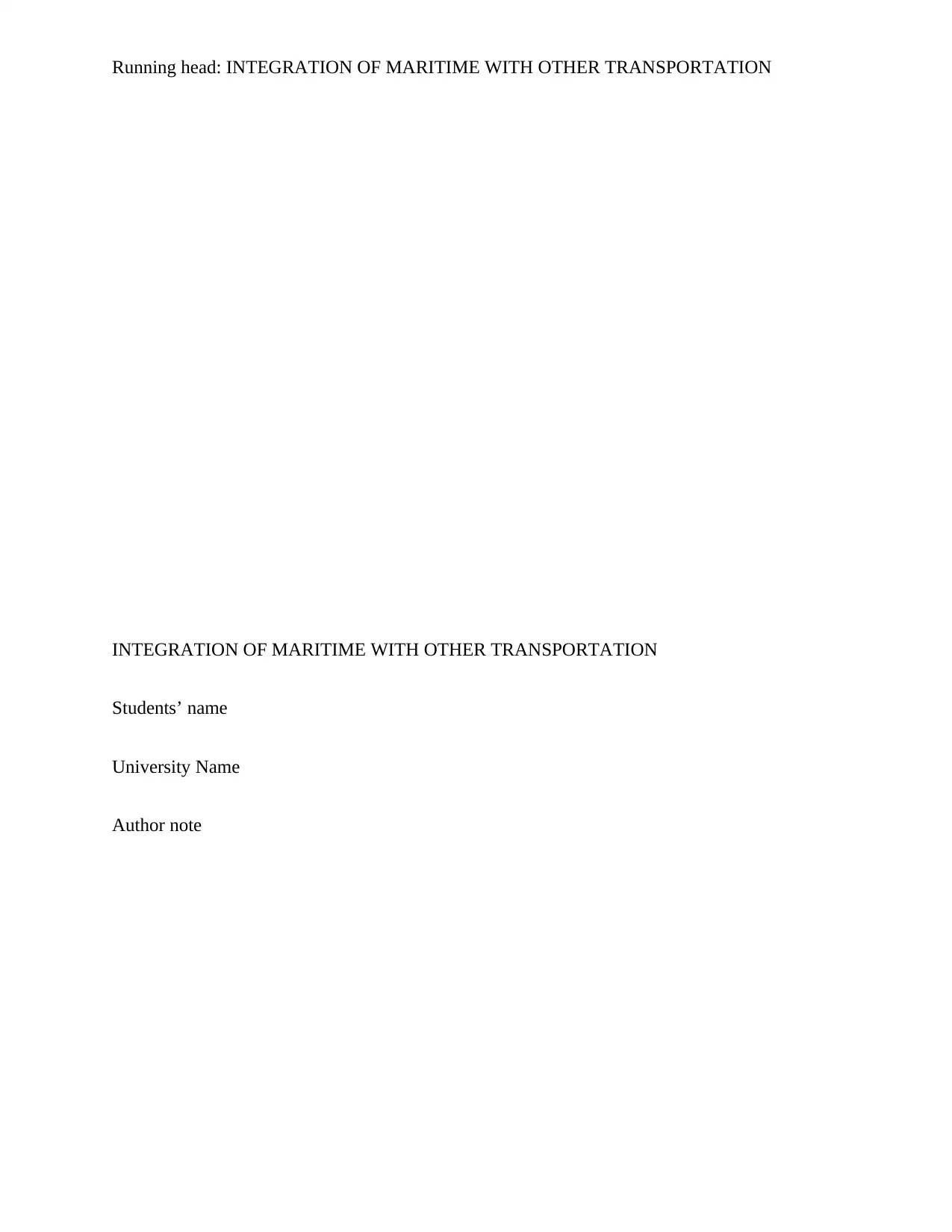
Running head: INTEGRATION OF MARITIME WITH OTHER TRANSPORTATION
INTEGRATION OF MARITIME WITH OTHER TRANSPORTATION
Students’ name
University Name
Author note
INTEGRATION OF MARITIME WITH OTHER TRANSPORTATION
Students’ name
University Name
Author note
Paraphrase This Document
Need a fresh take? Get an instant paraphrase of this document with our AI Paraphraser
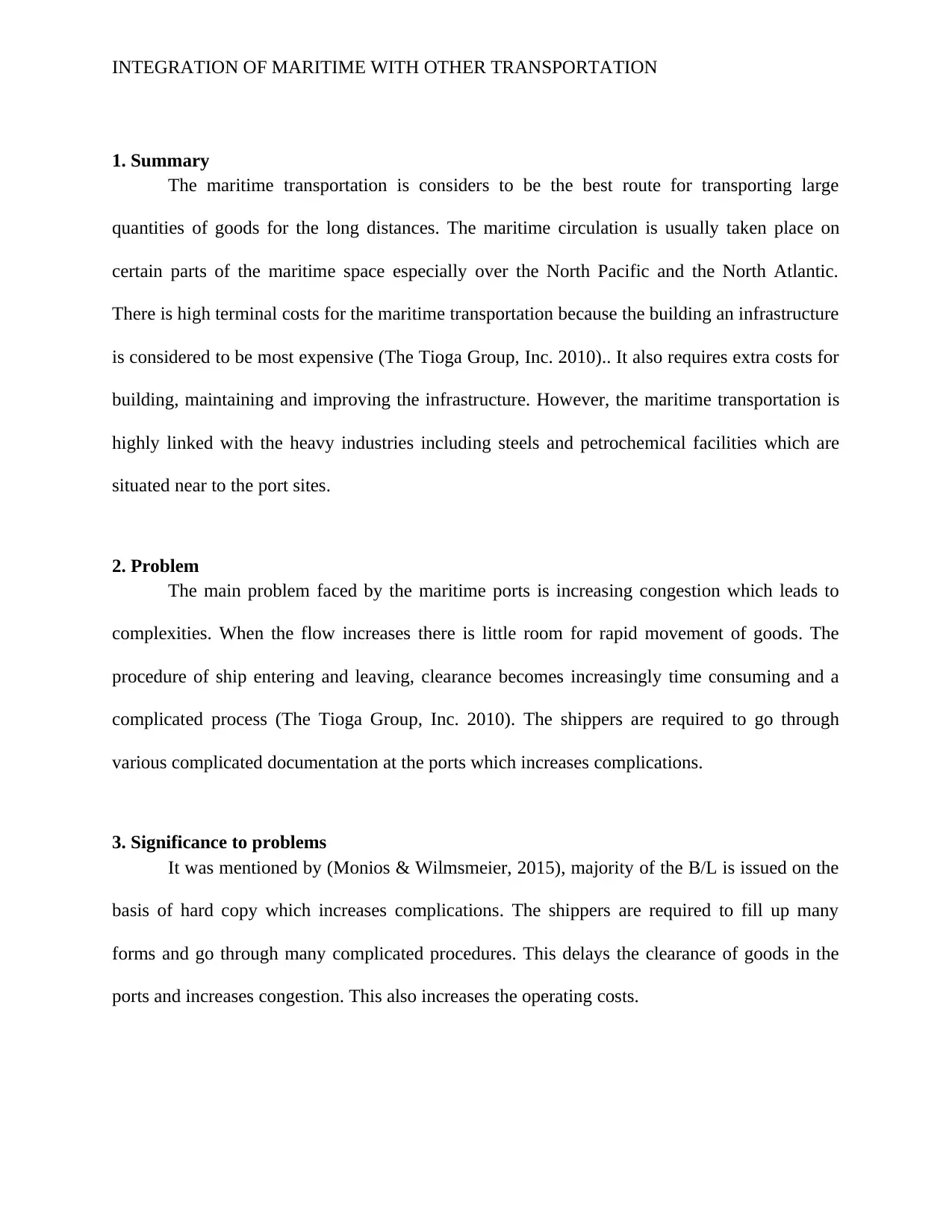
INTEGRATION OF MARITIME WITH OTHER TRANSPORTATION
1. Summary
The maritime transportation is considers to be the best route for transporting large
quantities of goods for the long distances. The maritime circulation is usually taken place on
certain parts of the maritime space especially over the North Pacific and the North Atlantic.
There is high terminal costs for the maritime transportation because the building an infrastructure
is considered to be most expensive (The Tioga Group, Inc. 2010).. It also requires extra costs for
building, maintaining and improving the infrastructure. However, the maritime transportation is
highly linked with the heavy industries including steels and petrochemical facilities which are
situated near to the port sites.
2. Problem
The main problem faced by the maritime ports is increasing congestion which leads to
complexities. When the flow increases there is little room for rapid movement of goods. The
procedure of ship entering and leaving, clearance becomes increasingly time consuming and a
complicated process (The Tioga Group, Inc. 2010). The shippers are required to go through
various complicated documentation at the ports which increases complications.
3. Significance to problems
It was mentioned by (Monios & Wilmsmeier, 2015), majority of the B/L is issued on the
basis of hard copy which increases complications. The shippers are required to fill up many
forms and go through many complicated procedures. This delays the clearance of goods in the
ports and increases congestion. This also increases the operating costs.
1. Summary
The maritime transportation is considers to be the best route for transporting large
quantities of goods for the long distances. The maritime circulation is usually taken place on
certain parts of the maritime space especially over the North Pacific and the North Atlantic.
There is high terminal costs for the maritime transportation because the building an infrastructure
is considered to be most expensive (The Tioga Group, Inc. 2010).. It also requires extra costs for
building, maintaining and improving the infrastructure. However, the maritime transportation is
highly linked with the heavy industries including steels and petrochemical facilities which are
situated near to the port sites.
2. Problem
The main problem faced by the maritime ports is increasing congestion which leads to
complexities. When the flow increases there is little room for rapid movement of goods. The
procedure of ship entering and leaving, clearance becomes increasingly time consuming and a
complicated process (The Tioga Group, Inc. 2010). The shippers are required to go through
various complicated documentation at the ports which increases complications.
3. Significance to problems
It was mentioned by (Monios & Wilmsmeier, 2015), majority of the B/L is issued on the
basis of hard copy which increases complications. The shippers are required to fill up many
forms and go through many complicated procedures. This delays the clearance of goods in the
ports and increases congestion. This also increases the operating costs.
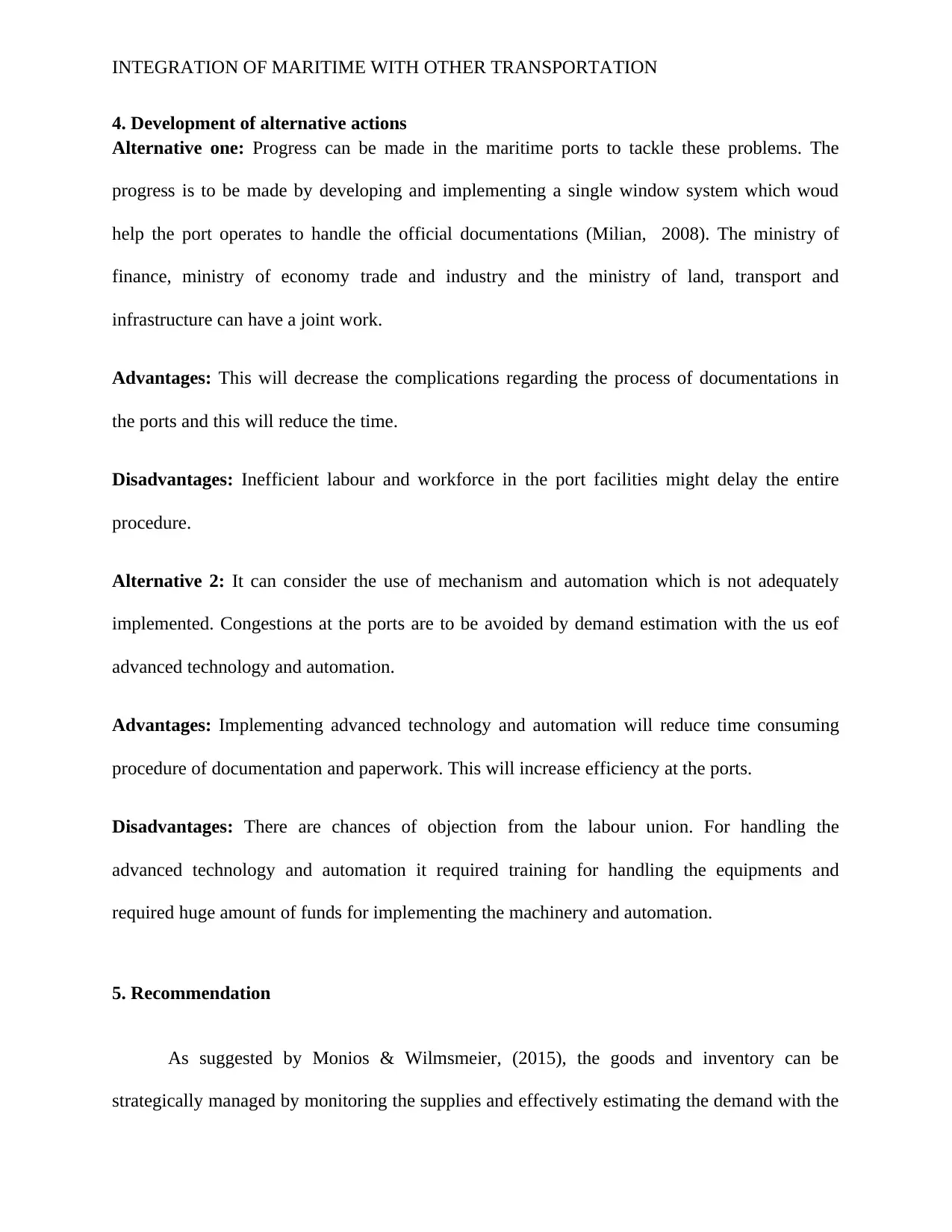
INTEGRATION OF MARITIME WITH OTHER TRANSPORTATION
4. Development of alternative actions
Alternative one: Progress can be made in the maritime ports to tackle these problems. The
progress is to be made by developing and implementing a single window system which woud
help the port operates to handle the official documentations (Milian, 2008). The ministry of
finance, ministry of economy trade and industry and the ministry of land, transport and
infrastructure can have a joint work.
Advantages: This will decrease the complications regarding the process of documentations in
the ports and this will reduce the time.
Disadvantages: Inefficient labour and workforce in the port facilities might delay the entire
procedure.
Alternative 2: It can consider the use of mechanism and automation which is not adequately
implemented. Congestions at the ports are to be avoided by demand estimation with the us eof
advanced technology and automation.
Advantages: Implementing advanced technology and automation will reduce time consuming
procedure of documentation and paperwork. This will increase efficiency at the ports.
Disadvantages: There are chances of objection from the labour union. For handling the
advanced technology and automation it required training for handling the equipments and
required huge amount of funds for implementing the machinery and automation.
5. Recommendation
As suggested by Monios & Wilmsmeier, (2015), the goods and inventory can be
strategically managed by monitoring the supplies and effectively estimating the demand with the
4. Development of alternative actions
Alternative one: Progress can be made in the maritime ports to tackle these problems. The
progress is to be made by developing and implementing a single window system which woud
help the port operates to handle the official documentations (Milian, 2008). The ministry of
finance, ministry of economy trade and industry and the ministry of land, transport and
infrastructure can have a joint work.
Advantages: This will decrease the complications regarding the process of documentations in
the ports and this will reduce the time.
Disadvantages: Inefficient labour and workforce in the port facilities might delay the entire
procedure.
Alternative 2: It can consider the use of mechanism and automation which is not adequately
implemented. Congestions at the ports are to be avoided by demand estimation with the us eof
advanced technology and automation.
Advantages: Implementing advanced technology and automation will reduce time consuming
procedure of documentation and paperwork. This will increase efficiency at the ports.
Disadvantages: There are chances of objection from the labour union. For handling the
advanced technology and automation it required training for handling the equipments and
required huge amount of funds for implementing the machinery and automation.
5. Recommendation
As suggested by Monios & Wilmsmeier, (2015), the goods and inventory can be
strategically managed by monitoring the supplies and effectively estimating the demand with the
⊘ This is a preview!⊘
Do you want full access?
Subscribe today to unlock all pages.

Trusted by 1+ million students worldwide
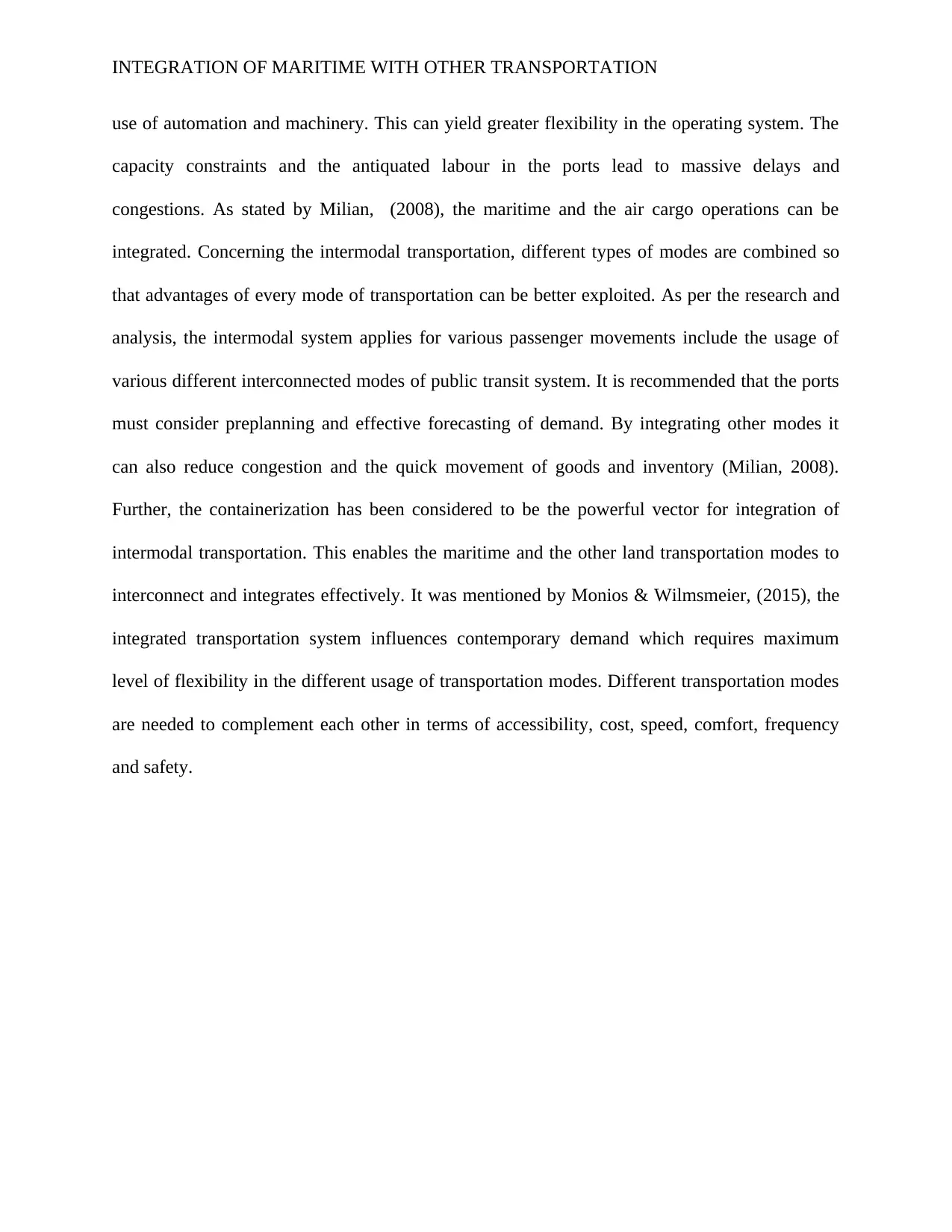
INTEGRATION OF MARITIME WITH OTHER TRANSPORTATION
use of automation and machinery. This can yield greater flexibility in the operating system. The
capacity constraints and the antiquated labour in the ports lead to massive delays and
congestions. As stated by Milian, (2008), the maritime and the air cargo operations can be
integrated. Concerning the intermodal transportation, different types of modes are combined so
that advantages of every mode of transportation can be better exploited. As per the research and
analysis, the intermodal system applies for various passenger movements include the usage of
various different interconnected modes of public transit system. It is recommended that the ports
must consider preplanning and effective forecasting of demand. By integrating other modes it
can also reduce congestion and the quick movement of goods and inventory (Milian, 2008).
Further, the containerization has been considered to be the powerful vector for integration of
intermodal transportation. This enables the maritime and the other land transportation modes to
interconnect and integrates effectively. It was mentioned by Monios & Wilmsmeier, (2015), the
integrated transportation system influences contemporary demand which requires maximum
level of flexibility in the different usage of transportation modes. Different transportation modes
are needed to complement each other in terms of accessibility, cost, speed, comfort, frequency
and safety.
use of automation and machinery. This can yield greater flexibility in the operating system. The
capacity constraints and the antiquated labour in the ports lead to massive delays and
congestions. As stated by Milian, (2008), the maritime and the air cargo operations can be
integrated. Concerning the intermodal transportation, different types of modes are combined so
that advantages of every mode of transportation can be better exploited. As per the research and
analysis, the intermodal system applies for various passenger movements include the usage of
various different interconnected modes of public transit system. It is recommended that the ports
must consider preplanning and effective forecasting of demand. By integrating other modes it
can also reduce congestion and the quick movement of goods and inventory (Milian, 2008).
Further, the containerization has been considered to be the powerful vector for integration of
intermodal transportation. This enables the maritime and the other land transportation modes to
interconnect and integrates effectively. It was mentioned by Monios & Wilmsmeier, (2015), the
integrated transportation system influences contemporary demand which requires maximum
level of flexibility in the different usage of transportation modes. Different transportation modes
are needed to complement each other in terms of accessibility, cost, speed, comfort, frequency
and safety.
Paraphrase This Document
Need a fresh take? Get an instant paraphrase of this document with our AI Paraphraser
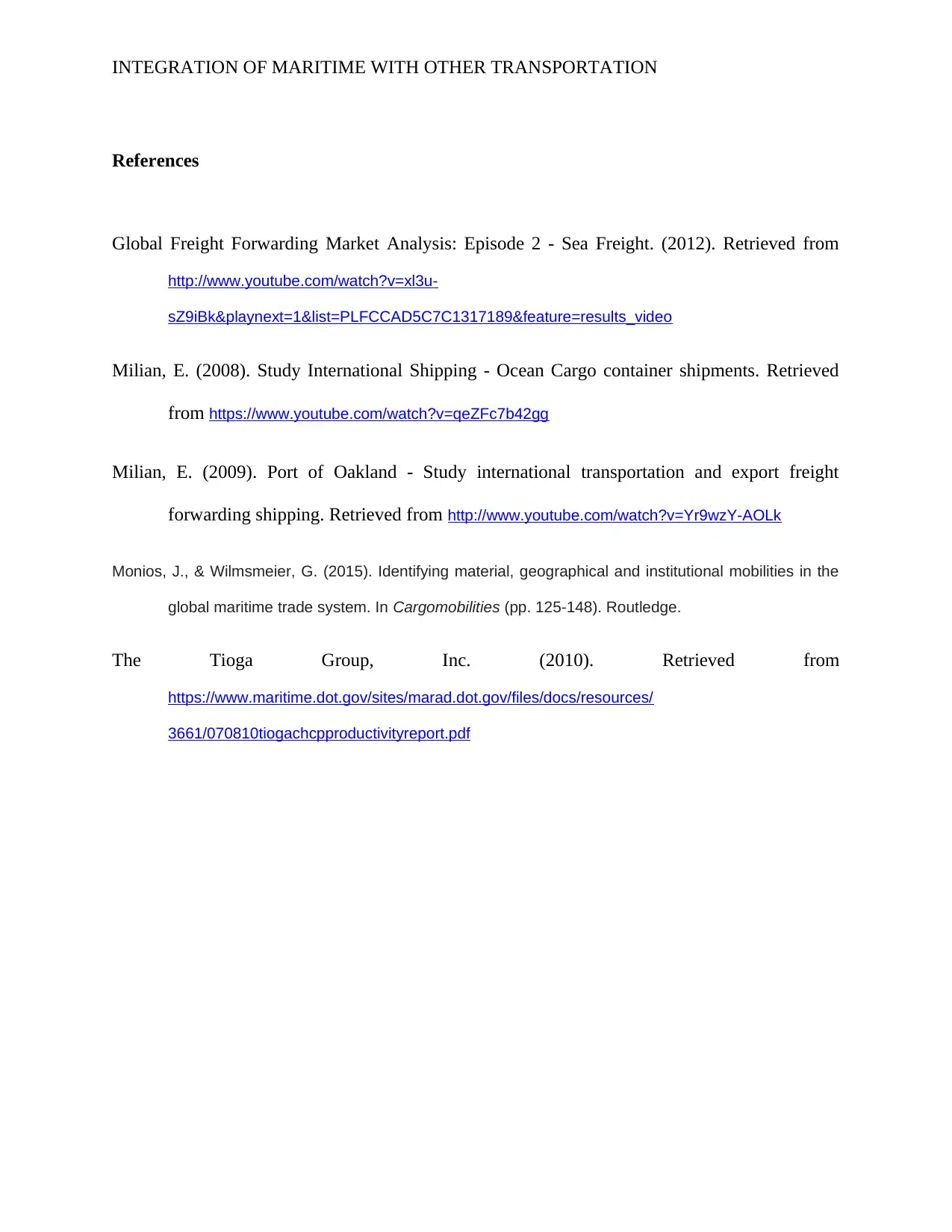
INTEGRATION OF MARITIME WITH OTHER TRANSPORTATION
References
Global Freight Forwarding Market Analysis: Episode 2 - Sea Freight. (2012). Retrieved from
http://www.youtube.com/watch?v=xl3u-
sZ9iBk&playnext=1&list=PLFCCAD5C7C1317189&feature=results_video
Milian, E. (2008). Study International Shipping - Ocean Cargo container shipments. Retrieved
from https://www.youtube.com/watch?v=qeZFc7b42gg
Milian, E. (2009). Port of Oakland - Study international transportation and export freight
forwarding shipping. Retrieved from http://www.youtube.com/watch?v=Yr9wzY-AOLk
Monios, J., & Wilmsmeier, G. (2015). Identifying material, geographical and institutional mobilities in the
global maritime trade system. In Cargomobilities (pp. 125-148). Routledge.
The Tioga Group, Inc. (2010). Retrieved from
https://www.maritime.dot.gov/sites/marad.dot.gov/files/docs/resources/
3661/070810tiogachcpproductivityreport.pdf
References
Global Freight Forwarding Market Analysis: Episode 2 - Sea Freight. (2012). Retrieved from
http://www.youtube.com/watch?v=xl3u-
sZ9iBk&playnext=1&list=PLFCCAD5C7C1317189&feature=results_video
Milian, E. (2008). Study International Shipping - Ocean Cargo container shipments. Retrieved
from https://www.youtube.com/watch?v=qeZFc7b42gg
Milian, E. (2009). Port of Oakland - Study international transportation and export freight
forwarding shipping. Retrieved from http://www.youtube.com/watch?v=Yr9wzY-AOLk
Monios, J., & Wilmsmeier, G. (2015). Identifying material, geographical and institutional mobilities in the
global maritime trade system. In Cargomobilities (pp. 125-148). Routledge.
The Tioga Group, Inc. (2010). Retrieved from
https://www.maritime.dot.gov/sites/marad.dot.gov/files/docs/resources/
3661/070810tiogachcpproductivityreport.pdf
1 out of 5
Your All-in-One AI-Powered Toolkit for Academic Success.
+13062052269
info@desklib.com
Available 24*7 on WhatsApp / Email
![[object Object]](/_next/static/media/star-bottom.7253800d.svg)
Unlock your academic potential
Copyright © 2020–2025 A2Z Services. All Rights Reserved. Developed and managed by ZUCOL.